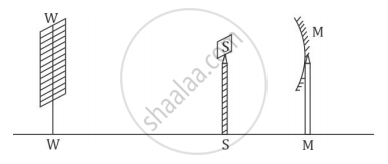Advertisements
Advertisements
Question
Size of image of an object by a mirror having a focal length of 20 cm is observed to be reduced to 1/3rd of its size. At what distance the object has been placed from the mirror? What is the nature of the image and the mirror?
Solution
Case I: (In case of convex mirror)
Magnification, `"m" = 1/3` (convex mirror)
Focal length (f) = 20 cm
Size of image `("h"_"i") = 1/3 xx "h"_"o"` (Size of object)
Using the magnification formula,
`"m" = "h"_"i"/"h"_"o" = (-upsilon)/"u"`
Substituting the values in the above equation,
`("h"_"o"/3)/"h"_"o" = (-upsilon)/"u"`
`1/3 = (-upsilon)/"u"`
`upsilon = (-"u")/3`
Using the mirror formula,
`1/upsilon + 1/"u" = 1/"f"`
`(-3)/"u" + 1/"u" = 1/20`
`(-2)/"u" = 1/20`
u = -40 cm
Negative sign shows that the object is in front of the mirror.
Substituting the above value in obtained image distance and object distance relation,
`upsilon = -u/3 = - ((-40))/3 = 40/3` cm
Thus, the image formed is virtual, erect and diminished. The object is at a distance of 40 cm from the mirror.
Case II: In case of concave mirror
Magnification, `"m" = -1/3` (concave mirror)
Focal length (f) = -20 cm
Using the magnification formula,
`"m" = "h"_"i"/"h"_"o" = (-upsilon)/"u"`
Substituting the values in the above equation,
`(-1)/3 = (-upsilon)/"u"`
`1/3 = upsilon/"u"`
`upsilon = "u"/3`
Using the mirror formula,
`1/upsilon + 1/"u" = 1/"f"`
`3/"u" + 1/"u" = 1/(-20)`
`4/"u" = 1/(-20)`
u = -80 cm
`upsilon = "u"/3 = -80/3` cm
Thus, the image will be real and inverted. The object is at a distance of 80 cm from the mirror.
APPEARS IN
RELATED QUESTIONS
A student obtains a sharp image of the distant window (W) of the school laboratory on the screen (S) using the given concave mirror (M) to determine its focal length. Which of the following distances should he measure to get the focal length of the mirror?

A lens forms a real image 3 cm high of an object 1 cm high. If the separation of object and image is 15 cm, find the focal length of the lens.
Mention the types of mirrors used as (i) rear view mirrors, (ii) shaving mirrors. List two reasons to justify your answers in each case.
If a spherical mirror breaks, what type of mirrors are the individual pieces?
An object of height 2 cm is placed at a distance of 20 cm in front of a concave mirror of a focal length of 12 cm. Find the position, size, and nature of the image.
What is “aperture”?
